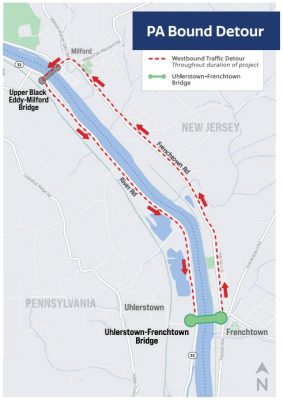FRENCHTOWN, NJ – An around-the-clock detour of Pennsylvania-bound vehicular traffic at the Uhlerstown-Frenchtown Toll-Supported Bridge is scheduled to begin on or about February 13, the Delaware River Joint Toll Bridge Commission announced today.
Once established, the PA-bound traffic detour is expected to remain in place without interruption until the fall. The removal of PA-bound traffic from the bridge’s road deck will enable a Commission contractor to install debris-containment measures for a multi-faceted rehabilitation of the 93-year-old structure during 2025.
PA-Bound Traffic Detour
The detour of PA-bound bridge traffic (MAP BELOW AND LINKED HERE) will be as follows, beginning at the corner of Bridge Street/NJ Route 12 and Harrison Street/County Route 619:
- Take Harrison Street/CR 619 north through Frenchtown toward Milford;
- Road becomes Frenchtown Road/CR 619, continue north;
- Shortly after entering Milford Borough, CR 619 merges into CR 519;
- Proceed to stop light in Milford Borough (intersection of Frenchtown Road/CR 519 and Bridge Street (gas station on right);
- Turn left onto Bridge Street;
- Proceed through Milford’s business district to the bridge at the river;
- Cross the Upper Black Eddy-Milford Toll-Supported Bridge into Pennsylvania and intersection with River Road/PA Route 32;
- Turn left onto River Road/PA Route 32 south;
- Proceed south toward the Uhlerstown-Frenchtown Bridge and other points south and west.
Initial work activities at the Uhlerstown-Frenchtown Bridge will involve the installation of debris-containment/work platforms below the bridge and above the bridge’s vehicular traffic lanes. This project set-up stage is expected to take up to four weeks to complete. The bridge will remain open to New Jersey-bound traffic and the walkway will remain in service during this period.
A bridge walkway closure is expected to begin in March and continue to September. This will allow for removal of the current concrete-filled steel-grid surface and installation a new widened surface.
NJ-bound traffic detours also will need to be instituted periodically for other rehabilitation activities later on in the project (dates and times to be announced when scheduled).
A primary focus for the contractor and its subcontractor this spring will be cleaning of the bridge down to bare metal with repairs being made where needed. A three-coat paint system will later be applied followed by electrical and lighting work.
The rehabilitation of the six-span Warren-truss bridge will include a litany of tasks, including – but not limited to – following:
- Repair various pieces of the bridge’s steel superstructure;
- Clean and repaint all truss sections and underlying bearings;
- Remove the bridge’s current guide rails and install new tubular-steel railings, increasing the bridge’s road deck by seven inches – from 16-feet, six inches to 17 feet, one inch.
- Replace the bridge’s roadway and pedestrian-walkway lighting systems;
- Remove the current concrete-filled steel-grid walkway surface and replace it with a wider system of slip-resistant foam-core fiber-reinforced-polymer panels and new pedestrian hand railings;
- Patch stone masonry spalls and replace concrete approach sidewalk sections;
- Repoint stone masonry and make other masonry repairs; and
- Install a programmable color-changing LED lighting system to highlight the bridge’s architectural profile at night.
The project’s construction contract was awarded to low-bidder Anselmi & DeCicco, Inc. of Maplewood, NJ. for a not-to-exceed amount of $22,216,237.00. A separate contract for construction-management/inspections services was awarded to Urban Engineers Incorporated of Cherry Hill, NJ. for a not-to-exceed amount of $1,587,138.62. All project costs ultimately are paid for by the tolls the Commission collects at its eight toll bridges.
The bridge between Frenchtown Borough, N.J. and the Uhlerstown section of Tinicum Township, PA. was last rehabilitated in 2001. The bridge superstructure has a 15-ton weight limit, a 12-foot, 6-inch height restriction, and a 15-MPH speed limit. It carried an average of 4,800 vehicles per day in 2024.

